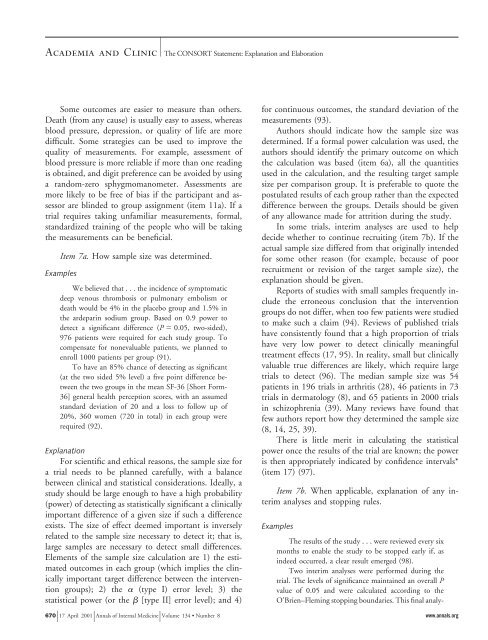The Revised CONSORT Statement for Reporting Randomized Trials
The Revised CONSORT Statement for Reporting Randomized Trials
The Revised CONSORT Statement for Reporting Randomized Trials
Create successful ePaper yourself
Turn your PDF publications into a flip-book with our unique Google optimized e-Paper software.
Academia and Clinic <strong>The</strong> <strong>CONSORT</strong> <strong>Statement</strong>: Explanation and Elaboration<br />
Some outcomes are easier to measure than others.<br />
Death (from any cause) is usually easy to assess, whereas<br />
blood pressure, depression, or quality of life are more<br />
difficult. Some strategies can be used to improve the<br />
quality of measurements. For example, assessment of<br />
blood pressure is more reliable if more than one reading<br />
is obtained, and digit preference can be avoided by using<br />
a random-zero sphygmomanometer. Assessments are<br />
more likely to be free of bias if the participant and assessor<br />
are blinded to group assignment (item 11a). If a<br />
trial requires taking unfamiliar measurements, <strong>for</strong>mal,<br />
standardized training of the people who will be taking<br />
the measurements can be beneficial.<br />
Item 7a. How sample size was determined.<br />
Examples<br />
We believed that ...theincidence of symptomatic<br />
deep venous thrombosis or pulmonary embolism or<br />
death would be 4% in the placebo group and 1.5% in<br />
the ardeparin sodium group. Based on 0.9 power to<br />
detect a significant difference (P 0.05, two-sided),<br />
976 patients were required <strong>for</strong> each study group. To<br />
compensate <strong>for</strong> nonevaluable patients, we planned to<br />
enroll 1000 patients per group (91).<br />
To have an 85% chance of detecting as significant<br />
(at the two sided 5% level) a five point difference between<br />
the two groups in the mean SF-36 [Short Form-<br />
36] general health perception scores, with an assumed<br />
standard deviation of 20 and a loss to follow up of<br />
20%, 360 women (720 in total) in each group were<br />
required (92).<br />
Explanation<br />
For scientific and ethical reasons, the sample size <strong>for</strong><br />
a trial needs to be planned carefully, with a balance<br />
between clinical and statistical considerations. Ideally, a<br />
study should be large enough to have a high probability<br />
(power) of detecting as statistically significant a clinically<br />
important difference of a given size if such a difference<br />
exists. <strong>The</strong> size of effect deemed important is inversely<br />
related to the sample size necessary to detect it; that is,<br />
large samples are necessary to detect small differences.<br />
Elements of the sample size calculation are 1) the estimated<br />
outcomes in each group (which implies the clinically<br />
important target difference between the intervention<br />
groups); 2) the (type I) error level; 3) the<br />
statistical power (or the [type II] error level); and 4)<br />
<strong>for</strong> continuous outcomes, the standard deviation of the<br />
measurements (93).<br />
Authors should indicate how the sample size was<br />
determined. If a <strong>for</strong>mal power calculation was used, the<br />
authors should identify the primary outcome on which<br />
the calculation was based (item 6a), all the quantities<br />
used in the calculation, and the resulting target sample<br />
size per comparison group. It is preferable to quote the<br />
postulated results of each group rather than the expected<br />
difference between the groups. Details should be given<br />
of any allowance made <strong>for</strong> attrition during the study.<br />
In some trials, interim analyses are used to help<br />
decide whether to continue recruiting (item 7b). If the<br />
actual sample size differed from that originally intended<br />
<strong>for</strong> some other reason (<strong>for</strong> example, because of poor<br />
recruitment or revision of the target sample size), the<br />
explanation should be given.<br />
Reports of studies with small samples frequently include<br />
the erroneous conclusion that the intervention<br />
groups do not differ, when too few patients were studied<br />
to make such a claim (94). Reviews of published trials<br />
have consistently found that a high proportion of trials<br />
have very low power to detect clinically meaningful<br />
treatment effects (17, 95). In reality, small but clinically<br />
valuable true differences are likely, which require large<br />
trials to detect (96). <strong>The</strong> median sample size was 54<br />
patients in 196 trials in arthritis (28), 46 patients in 73<br />
trials in dermatology (8), and 65 patients in 2000 trials<br />
in schizophrenia (39). Many reviews have found that<br />
few authors report how they determined the sample size<br />
(8, 14, 25, 39).<br />
<strong>The</strong>re is little merit in calculating the statistical<br />
power once the results of the trial are known; the power<br />
is then appropriately indicated by confidence intervals*<br />
(item 17) (97).<br />
Item 7b. When applicable, explanation of any interim<br />
analyses and stopping rules.<br />
Examples<br />
<strong>The</strong> results of the study ...were reviewed every six<br />
months to enable the study to be stopped early if, as<br />
indeed occurred, a clear result emerged (98).<br />
Two interim analyses were per<strong>for</strong>med during the<br />
trial. <strong>The</strong> levels of significance maintained an overall P<br />
value of 0.05 and were calculated according to the<br />
O’Brien–Fleming stopping boundaries. This final analy-<br />
670 17 April 2001 Annals of Internal Medicine Volume 134 • Number 8 www.annals.org
















